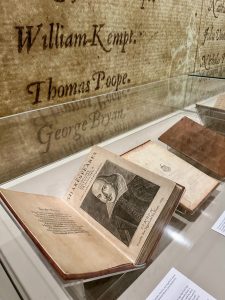Cranes & The Long Lives of Very Old Books
AUSTIN — The Harry Ransom Center on the University of Texas campus is one of the best bargains in this increasingly expensive city since admission is free. Competing for the Best Bargain prize is walking the trail at Lady Bird Lake, again free. I did both recently to get my A-Town fix as well as breaking bread with longtime friends and my brother Scott.
It was downright chilly when I walked the trail where it adjoins Rainey Street, once a home of modest frame homes now completely transformed into a forest of high-rise condos. I remember the old joke when I was in graduate school here in 1980 that the city’s official bird is the building crane. Well, the crane is back, dotting the skyline as more tall buildings go up. As always, I enjoy the various dogs that I encounter on my walk — the Australian shepherd leaping in the air to c atch a Frisbee thrown by its owner, a bug-eyed Boston terrier walking as fast as its short legs would allow, a mixed-breed something-or-other chasing a squirrel with the usual result. The squirrel easily escapes.
atch a Frisbee thrown by its owner, a bug-eyed Boston terrier walking as fast as its short legs would allow, a mixed-breed something-or-other chasing a squirrel with the usual result. The squirrel easily escapes.
Last time I lived here, about a dozen years ago, I had a notion of setting up a parabolic microphone along a congested piece of the trail, and recording the snatches of conversation as folks walked, jogged and cycled by, then turning it into a play. I still think the idea has merit, though I will not be following through. Feel free to steal this idea if you wish.
|———|
I arrived at the Ransom Center when it opened at 10 a.m. to view an exhibit definitely in my wheelhouse: The Long Lives of Very Old Books. More than 150 books published in Europe between the mid-15th century and the late 17th century are on exhibit through Dec. 30. All are safely ensconced in glass cases under dim light. Included in the exhibit are three of the center’s copies of the Shakespeare First Folio, which is the first published collection of the Bard’s plays. Officially titled Mr. William Shakespeare’s Comedies, Histories & Tragedies, the First Folio is marking its 400th anniversary this year. The center has three copies of the First Folio, of which about 235 have survived four centuries.
 Also on display is a Bible that is believed to have traveled to New England aboard the Mayflower, a copy of Don Quixote that was annotated by what the Center’s website calls “a class-conscious reader.” I wandered about, reading the descriptions and unsuccessfully trying to imagine the journey these books took to end up in Austin, Texas in 2023.
Also on display is a Bible that is believed to have traveled to New England aboard the Mayflower, a copy of Don Quixote that was annotated by what the Center’s website calls “a class-conscious reader.” I wandered about, reading the descriptions and unsuccessfully trying to imagine the journey these books took to end up in Austin, Texas in 2023.
The HRC, as it is commonly called, is a vast repository of the work of some of civilization’s finest writers and artists. The building is 10 stories tall with a quarter-million square feet of space. The collection includes nearly 1 million books, more than 42 million manuscripts, 5 million photographs and 100,000 works of art, according to its website. The HRC owns the earliest surviving photograph, made on pewter by Joseph Nicéphore Niépce in France in 1827. He called it a heliograph — writing with the sun. As I told the students in my photography class when I torture them with a history of photography lecture toward the end of the semester, the exposure took several days and shows (rather hazily) a courtyard visible from his second-story workroom. Because of the long exposure, any people or animals who might have been in the courtyard were not there long enough to be part of the image.
For a brief time while I was working toward my master’s in photojournalism at UT, I volunteered for class credit to work deep in the bowels of the HRC. My task was to catalog part of a newspaper morgue of the Journal-American a New York City newspaper that ceased publishing in 1966. That is where my interest in archives was sparked.
After about 90 minutes marveling over these books, it was time to begin the five-hour journey back to East Texas. The trees along the route home are rapidly losing leaves. Winter is upon us.
Leave a reply
Fields marked with * are required











